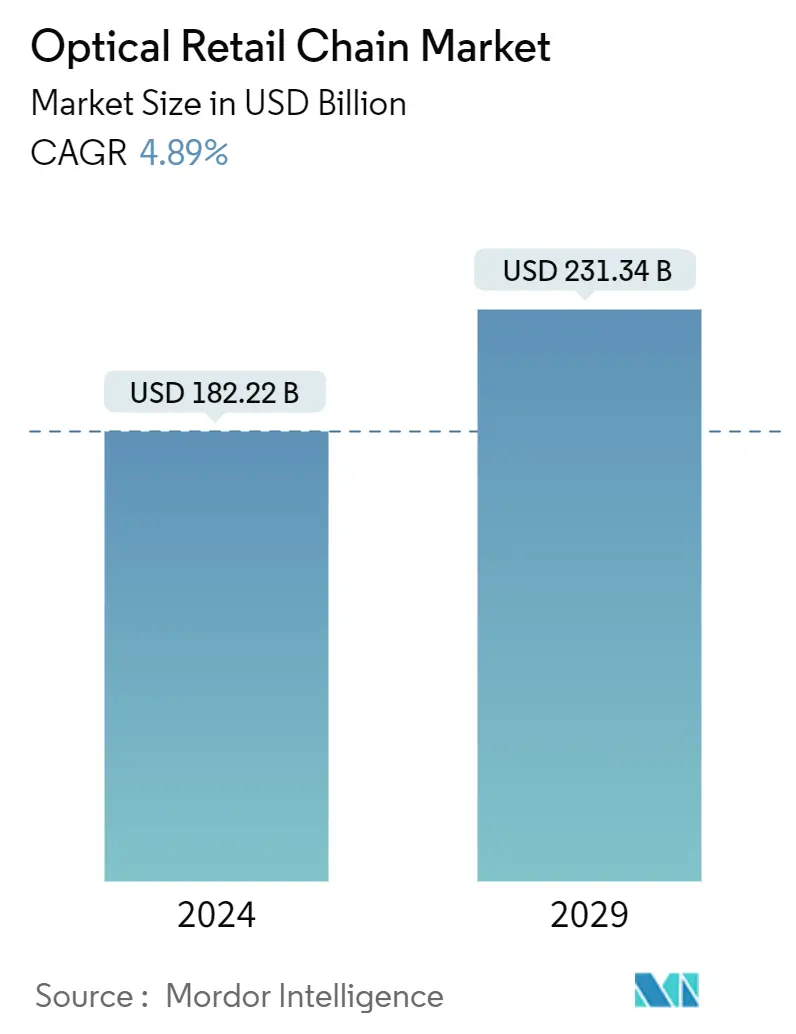
| Study Period | 2020-2029 |
| Market Size (2024) | USD 182.22 Billion |
| Market Size (2029) | USD 231.34 Billion |
| CAGR (2024 - 2029) | 4.89 % |
| Fastest Growing Market | North America |
| Largest Market | North America |
| Market Concentration | Low |
Major Players
*Disclaimer: Major Players sorted in no particular order |
Optical Retail Chain Market Analysis
The Optical Retail Chain Market size is estimated at USD 182.22 billion in 2024, and is expected to reach USD 231.34 billion by 2029, growing at a CAGR of 4.89% during the forecast period (2024-2029).
The optical retail chain market refers to the industry sector composed of businesses selling eyeglasses, contact lenses, sunglasses, and related visual products through retail stores. These chains typically operate multiple locations across various regions or countries, offering consumers a wide range of eyewear products and services.
Optical retail chains usually offer diverse eyewear products, including prescription glasses, sunglasses, contact lenses, and accessories such as cases and cleaning solutions. Many optical retail chains provide additional services such as eye exams conducted by licensed optometrists or opticians, eyeglasses adjustments and repairs, and assistance selecting frames or lenses. Changing demographics, fashion trends, and lifestyle preferences impact consumer demand for eyewear products and services. Increasing awareness of eye health, fashion-conscious consumers, and the rise of digital device usage may influence purchasing decisions. Many optical retail chains have an online presence, allowing customers to browse products, schedule appointments, and even purchase eyewear remotely. Integrating online and offline channels is becoming increasingly important in the optical retail sector.
Optical Retail Chain Industry Segmentation
Optical retail chains are businesses primarily selling prescription and non-prescription eyewear, including lenses, eyeglasses, and contact lenses. They typically operate numerous outlets across various locations, providing consumers with multiple eyewear options. The optical retail chain market forecast is segmented by product (spectacles, sunglasses, and contact lenses), gender (men, women, and unisex), distribution channel (offline online), and geography (Asia-Pacific, North America, Europe, South America, and the Middle East & Africa). The report offers the market size in value terms in USD for all the abovementioned segments. The report offers the market size in value terms in USD for all the abovementioned segments.
| Beauty and Personal Care |
| Food And Beverages |
| Entertainment |
| Others Services |
| Men |
| Women |
| Kids |
| Online Payment |
| Cash on Delivery |
| Asia-Pacific | India |
| China | |
| Japan | |
| Australia | |
| Rest of Asia- Pacific | |
| North America | United States |
| Canada | |
| Rest of North America | |
| Europe | Germany |
| United Kingdom | |
| France | |
| Russia | |
| Rest of Europe | |
| South America | Brazil |
| Argentina | |
| Rest of South America | |
| Middle East & Africa | United Arab Emirates |
| South Africa | |
| Rest of Middle East & Africa |
Optical Retail Chain Market Size Summary
The optical retail chain market encompasses businesses that sell eyewear products such as eyeglasses, contact lenses, and sunglasses through multiple retail locations. This sector is characterized by its diverse offerings, including prescription glasses, fashion sunglasses, and various accessories, alongside services like eye exams and lens adjustments. The market is influenced by changing consumer demographics, fashion trends, and the increasing use of digital devices, which shape demand for eyewear. The integration of online and offline channels is becoming crucial, as many chains expand their digital presence to enhance customer engagement and convenience. The rising prevalence of ocular diseases and the aging population globally are driving demand for vision care products and services, further propelling market growth.
North America, particularly the United States, leads the optical retail chain market, followed by Europe, with well-established consumer awareness and access to vision care services. The market is fragmented, featuring a mix of large international brands and independent regional stores, with significant players like Luxottica Group, Essilor International, and Johnson & Johnson Vision Care. These companies often collaborate with trusted brands to enhance their market presence. Recent strategic moves, such as Johnson & Johnson's divestment of its Blink product line and Alcon's acquisition of Aerie Pharmaceuticals, highlight ongoing efforts to strengthen their positions within the industry.
Optical Retail Chain Market Size - Table of Contents
1. MARKET DYNAMICS AND INSIGHTS
- 1.1 Market Overview
-
1.2 Market Drivers
- 1.2.1 Increasing Awareness of Eye Health
- 1.2.2 Eyewear has Become an Integral Fashion Accessory
-
1.3 Market Restraints
- 1.3.1 Changes in Healthcare Policies and Insurance Coverage for Vision Care
-
1.4 Market Opportunties
- 1.4.1 Offering Personalized Eyewear Solutions
- 1.5 Value Chain Analysis
-
1.6 Industry Attractiveness: Porter's Five Forces Analysis
- 1.6.1 Threat of New Entrants
- 1.6.2 Bargaining Power of Buyers
- 1.6.3 Bargaining Power of Suppliers
- 1.6.4 Threat of Substitutes
- 1.6.5 Intensity of Competitive Rivalry
- 1.7 Insights into Technological Advancements in the Industry
- 1.8 Impact of COVID-19 on the Market
2. MARKET SEGMENTATION
-
2.1 By Service
- 2.1.1 Beauty and Personal Care
- 2.1.2 Food And Beverages
- 2.1.3 Entertainment
- 2.1.4 Others Services
-
2.2 By End User
- 2.2.1 Men
- 2.2.2 Women
- 2.2.3 Kids
-
2.3 By Mode of Payment
- 2.3.1 Online Payment
- 2.3.2 Cash on Delivery
-
2.4 By Geography
- 2.4.1 Asia-Pacific
- 2.4.1.1 India
- 2.4.1.2 China
- 2.4.1.3 Japan
- 2.4.1.4 Australia
- 2.4.1.5 Rest of Asia- Pacific
- 2.4.2 North America
- 2.4.2.1 United States
- 2.4.2.2 Canada
- 2.4.2.3 Rest of North America
- 2.4.3 Europe
- 2.4.3.1 Germany
- 2.4.3.2 United Kingdom
- 2.4.3.3 France
- 2.4.3.4 Russia
- 2.4.3.5 Rest of Europe
- 2.4.4 South America
- 2.4.4.1 Brazil
- 2.4.4.2 Argentina
- 2.4.4.3 Rest of South America
- 2.4.5 Middle East & Africa
- 2.4.5.1 United Arab Emirates
- 2.4.5.2 South Africa
- 2.4.5.3 Rest of Middle East & Africa
Optical Retail Chain Market Research FAQs
How big is the Optical Retail Chain Market?
The Optical Retail Chain Market size is expected to reach USD 191.13 billion in 2025 and grow at a CAGR of 4.89% to reach USD 242.66 billion by 2030.
What is the current Optical Retail Chain Market size?
In 2025, the Optical Retail Chain Market size is expected to reach USD 191.13 billion.


